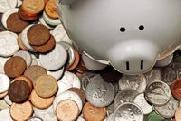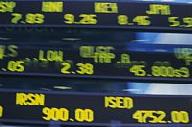
 |
|
| Financial Terms | |
| Vehicles |
|
Information about financial, finance, business, accounting, payroll, inventory, investment, money, inventory control, stock trading, financial advisor, tax advisor, credit.
Main Page: financial advisor, accounting, financial, inventory, credit, money, investment, inventory control, |
Definition of Vehicles
VehiclesThe cost of transportation equipment owned by the company.
Related Terms:Tangible fixed assetsPhysical assets that can be seen and touched, e.g. buildings, machinery, vehicles, computers etc. capital expendituresRefers to investments by a business in long-term fixed assetsAn informal term that refers to the variety of long-term operating property, plant, and equipmentThis label is generally used in financial Business Expansion InvestmentThe use of capital to create more money through the addition of fixed assets or through income producing vehicles. Acquisition of assetsA merger or consolidation in which an acquirer purchases the selling firm's assets. AssetsA firm's productive resources.  Assets requirementsA common element of a financial plan that describes projected capital spending and the Average cost of capitalA firm's required payout to the bondholders and to the stockholders expressed as a CapitalMoney invested in a firm. Capital accountNet result of public and private international investment and lending activities. Capital allocationdecision Allocation of invested funds between risk-free assets versus the risky portfolio. Capital asset pricing model (CAPM)An economic theory that describes the relationship between risk and Capital budgetA firm's set of planned capital expenditures. Capital budgetingThe process of choosing the firm's long-term capital assets. Capital flightThe transfer of capital abroad in response to fears of political risk.  Capital gainWhen a stock is sold for a profit, it's the difference between the net sales price of securities and Capital gains yieldThe price change portion of a stock's return. Capital leaseA lease obligation that has to be capitalized on the balance sheet. Capital lossThe difference between the net cost of a security and the net sale price, if that security is sold at a loss. Capital marketThe market for trading long-term debt instruments (those that mature in more than one year). Capital market efficiencyReflects the relative amount of wealth wasted in making transactions. An efficient Capital market imperfections viewThe view that issuing debt is generally valuable but that the firm's Capital market line (CML)The line defined by every combination of the risk-free asset and the market portfolio. Capital rationingPlacing one or more limits on the amount of new investment undertaken by a firm, either Capital structureThe makeup of the liabilities and stockholders' equity side of the balance sheet, especially Capital surplusAmounts of directly contributed equity capital in excess of the par value.  CapitalizationThe debt and/or equity mix that fund a firm's assets. Capitalization methodA method of constructing a replicating portfolio in which the manager purchases a Capitalization ratiosAlso called financial leverage ratios, these ratios compare debt to total capitalization Capitalization tableA table showing the capitalization of a firm, which typically includes the amount of CapitalizedRecorded in asset accounts and then depreciated or amortized, as is appropriate for expenditures Capitalized interestInterest that is not immediately expensed, but rather is considered as an asset and is then Complete capital marketA market in which there is a distinct marketable security for each and every Cost of capitalThe required return for a capital budgeting project. Cost of limited partner capitalThe discount rate that equates the after-tax inflows with outflows for capital Current assetsValue of cash, accounts receivable, inventories, marketable securities and other assets that Dedicated capitalTotal par value (number of shares issued, multiplied by the par value of each share). Also Efficient capital marketA market in which new information is very quickly reflected accurately in share Exchange of assetsAcquisition of another company by purchase of its assets in exchange for cash or stock. Financial assetsClaims on real assets. Fixed assetLong-lived property owned by a firm that is used by a firm in the production of its income. Fixed asset turnover ratioThe ratio of sales to fixed assets. Fixed costA cost that is fixed in total for a given period of time and for given production levels. Fixed-annuitiesAnnuity contracts in which the insurance company or issuing financial institution pays a Fixed-charge coverage ratioA measure of a firm's ability to meet its fixed-charge obligations: the ratio of Fixed-datesIn the Euromarket the standard periods for which Euros are traded (1 month out to a year out) are Fixed-dollar obligationsConventional bonds for which the coupon rate is set as a fixed percentage of the par value. Fixed-dollar securityA nonnegotiable debt security that can be redeemed at some fixed price or according to Fixed-exchange rateA country's decision to tie the value of its currency to another country's currency, gold Fixed-income equivalentAlso called a busted convertible, a convertible security that is trading like a straight Fixed-income instrumentsassets that pay a fixed-dollar amount, such as bonds and preferred stock. Fixed-income marketThe market for trading bonds and preferred stock. Fixed price basisAn offering of securities at a fixed price. Fixed-price tender offerA one-time offer to purchase a stated number of shares at a stated fixed price, Fixed-rate loanA loan on which the rate paid by the borrower is fixed for the life of the loan. Fixed-rate payerIn an interest rate swap the counterparty who pays a fixed rate, usually in exchange for a Hard capital rationingcapital rationing that under no circumstances can be violated. Human capitalThe unique capabilities and expertise of individuals. Intangible assetA legal claim to some future benefit, typically a claim to future cash. Goodwill, intellectual Issued share capitalTotal amount of shares that are in issue. Related: outstanding shares. Legal capitalValue at which a company's shares are recorded in its books. Long-term assetsValue of property, equipment and other capital assets minus the depreciation. This is an Long-term debt/capitalizationIndicator of financial leverage. Shows long-term debt as a proportion of the Market capitalizationThe total dollar value of all outstanding shares. Computed as shares times current Market capitalization rateExpected return on a security. The market-consensus estimate of the appropriate Net assetsThe difference between total assets on the one hand and current liabilities and noncapitalized longterm Net working capitalCurrent assets minus current liabilities. Often simply referred to as working capital. Non-reproducible assetsA tangible asset with unique physical properties, like a parcel of land, a mine, or a Nondiversifiability of human capitalThe difficulty of diversifying one's human capital (the unique Opportunity cost of capitalExpected return that is foregone by investing in a project rather than in Other capitalIn the balance of payments, other capital is a residual category that groups all the capital Other current assetsValue of non-cash assets, including prepaid expenses and accounts receivable, due Outstanding share capitalIssued share capital less the par value of shares that are held in the company's treasury. Pecking-order view (of capital structure)The argument that external financing transaction costs, especially Perfect capital marketA market in which there are never any arbitrage opportunities. Perfect market view (of capital structure)Analysis of a firm's capital structure decision, which shows the Personal tax view (of capital structure)The argument that the difference in personal tax rates between Pie model of capital structureA model of the debt/equity ratio of the firms, graphically depicted in slices of Planned capital expenditure programcapital expenditure program as outlined in the corporate financial plan. Pro forma capital structure analysisA method of analyzing the impact of alternative capital structure Publicly traded assetsassets that can be traded in a public market, such as the stock market. Quick assetsCurrent assets minus inventories. Real assetsIdentifiable assets, such as buildings, equipment, patents, and trademarks, as distinguished from a Real capitalWealth that can be represented in financial terms, such as savings account balances, financial Reproducible assetsA tangible asset with physical properties that can be reproduced, such as a building or Residual assetsassets that remain after sufficient assets are dedicated to meet all senior debtholder's claims in full. Return on assets (ROA)Indicator of profitability. Determined by dividing net income for the past 12 months Return on total assetsThe ratio of earnings available to common stockholders to total assets. "Soft" Capital Rationingcapital rationing that under certain circumstances can be violated or even viewed Static theory of capital structureTheory that the firm's capital structure is determined by a trade-off of the Tangible assetAn asset whose value depends on particular physical properties. These i nclude reproducible Venture capitalAn investment in a start-up business that is perceived to have excellent growth prospects but Weighted average cost of capitalExpected return on a portfolio of all the firm's securities. Used as a hurdle Working capitalDefined as the difference in current assets and current liabilities (excluding short-term Working capital managementThe management of current assets and current liabilities to maximize shortterm liquidity. Working capital ratioWorking capital expressed as a percentage of sales. ASSETSAnything of value that a company owns. CAPITALThe money, raised by selling stock or bonds or taking out loans, that you use to start, operate, and grow a business. CAPITAL IN EXCESS OF PAR VALUEWhat a company collected when it sold stock for more than the par value per share. Current assetsCash, things that will be converted into cash within a year (such as accounts receivable), and inventory. RATE OF RETURN ON TOTAL ASSETSThe percentage return or profit that management made on each dollar of assets. The formula is: AssetsThings that the business owns. CapitalThe shareholders’ investment in the business; the difference between the assets and liabilities Related to : financial, finance, business, accounting, payroll, inventory, investment, money, inventory control, stock trading, financial advisor, tax advisor, credit. |